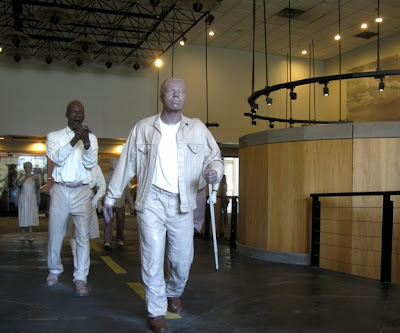In a previous post, I described Midtown as the heart of Atlanta. And while that's true, Sweet Auburn is most definitely the soul of this wonderful city. After General William Tecumseh Sherman invaded, captured, and burned most of Atlanta to the ground, Union Troops occupied land just outside of downtown Atlanta, and that occupied area became known as Shermantown.
Shermantown's close proximity to the Georgia Railroad, and the connecting road known simply as Boulevard, sparked quick development. By the early 1900s, Shermantown was an officially segregated "Negro" neighborhood, with a thriving African-American community. The African-American civic leader, author, and unofficial "Mayor of Auburn Avenue", John Wesley Dobbs began to call his neighborhood, Sweet Auburn - a reference to the first line of the 1770 poem, "The Deserted Village," by Irish poet Oliver Goldsmith, which starts, "Sweet Auburn, loveliest village of the plain," and Fortune Magazine referred to Auburn Avenue as the "richest Negro street in America."
In spite of the harsh reality of Jim Crow, Sweet Auburn prospered throughout the first half of the twentieth century, with African-American churches,businesses, and civic organizations lining Auburn Avenue. During the week, entrepreneurs read the African-American newspaper, the "Atlanta Daily World." Jazz greats like Duke Ellington and Cab Calloway played the nightclubs on Saturday night and churches, like Big Bethel AME, and Wheat Street Baptist nurtured the African-American spirit on Sunday morning.
The Sweet Auburn churches provided not only a place to worship and socialize, but they became home to the ideas and conversations that gave birth to the great Civil Rights Movement. The Ebenezer Baptist Church , on the corner of Auburn Avenue and Jackson Street, was led by Pastor Martin Luther King, Sr., who became a community leader and activist. His son, Dr. Martin Luther King, Jr. became the most prominent leader of the Civil Rights Movement.
In 1976, the entire neighborhood was designated a National Historic Landmark, and the following year a memorial tomb was placed, on a reflecting pool, in a plaza just east of Ebenezer Baptist Church, and Dr. King's remains were moved from South View Cemetery to the site. In 1981, the Martin Luther King Jr. Center for Non-Violent Social Change was opened on Auburn Avenue, where Dr. King's widow, Coretta Scott King, worked to carry the message of justice, equality, and peace to future generations.
Like many inner city neighborhoods, the 1970s and 1980s were not the best years in the history of Sweet Auburn, and the area fell into significant disrepair. Buildings were abandoned and street drug dealing and crime were common. This wonderfully historic neighborhood is, unfortunately, still struggling with these issues, though there are visible glimmers of hope all along Auburn Avenue and Edgewood Avenue. There are new restaurants and coffee shops, and the annual Sweet Auburn Festival draws nearly 500,000 folks from all over to enjoy a day of music, entertainment, and African-American history.
Sweet Auburn grew from a small neighborhood born of violently enforced racial segregation, into a symbol of the strength of the human spirit in the face of oppression, degradation, and injustice. This small community, of hard-working sons and daughters of slaves, gave the world a dream, a spirit, and a message of hope, that continues to speak its truth today.
Like many inner city neighborhoods, the 1970s and 1980s were not the best years in the history of Sweet Auburn, and the area fell into significant disrepair. Buildings were abandoned and street drug dealing and crime were common. This wonderfully historic neighborhood is, unfortunately, still struggling with these issues, though there are visible glimmers of hope all along Auburn Avenue and Edgewood Avenue. There are new restaurants and coffee shops, and the annual Sweet Auburn Festival draws nearly 500,000 folks from all over to enjoy a day of music, entertainment, and African-American history.
Sweet Auburn grew from a small neighborhood born of violently enforced racial segregation, into a symbol of the strength of the human spirit in the face of oppression, degradation, and injustice. This small community, of hard-working sons and daughters of slaves, gave the world a dream, a spirit, and a message of hope, that continues to speak its truth today.



















As always, a comprehensive historic and artistic piece.
ReplyDeletefascinating stuff! My next trip will have to include some more time in the neighborhood.
ReplyDelete